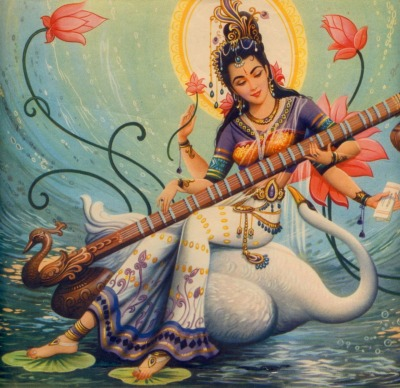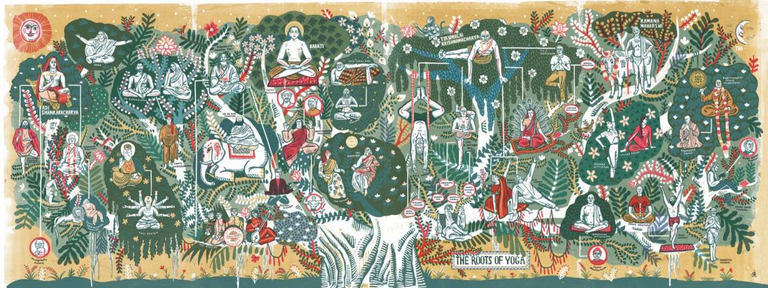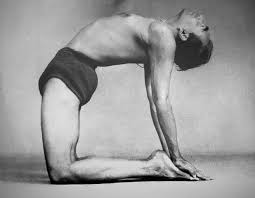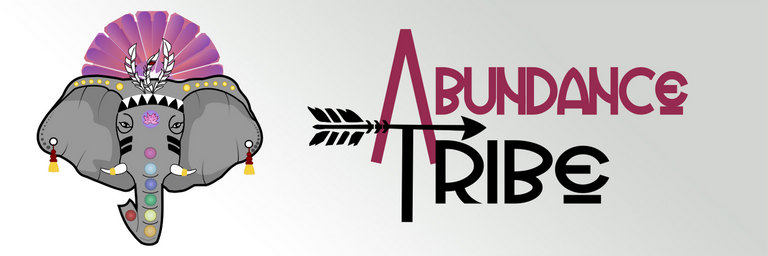To begin this post, I have to summon Saraswati, the Hindu goddess of the arts. They say when you articulate something so well it moves another, Saraswati dances on your tongue. She's the one that is with you when you drop all your stories, all your concerns about performances and judgements, and create in a way that it no longer seems like you are doing - instead, the muse is moving through you. She's present in paintings that pull you into their scene, in the lines of poetry that make your heart bleed, in the sound of a concerto or a drumbeat that make your heart thrum, in music that makes you want to close your eyes and abandon your limbs to the magic of dance.

Jai Maa Saraswati
Saraswati doesn't seem to have a place in yoga - not the rigidity of form that we might adhere to as we are instructed to 'step your left foot forward, turn your right foot in ninety degrees, bend your left knee no further than your left ankle, and rise into Warrior 1'. There is a precision of movement there that is designed to move you into a specific asana, or body posture - a twist, an inversion, a balance, a back or forward bend - and in the depths of yogic history, originally merely a 'comfortable seat' for meditation, as Patanjali's yoga sutras put it: 'a position that is steady and comfortable'.
In the 15th century yoga text the Hatha Yoga Pradipika, and as far back as the 10th century Goraksha Sataka, there were 84 asanas. By the 20th century, responding to the presence of the colonial British who admired the gymnastics of yoga as a physical exercise, new teachers brought in extra poses and sequences of movement in addition, and in respect of, these 84 poses. Famously, Pattabi Jois (father of Ashtanga vinyasa yoga) and B.K.S Iyenger, both from the Krishnamacharya lineage, expanded these poses into hundreds more.
The 10th or 11th century Goraksha Sataka and the 15th century Hatha Yoga Pradipika identify 84 asanas; the 17th century Hatha Ratnavali provides a different list of 84 asanas, describing some of them. In the 20th century, Indian nationalism favoured physical culture in response to colonialism. In that environment, pioneers such as Yogendra, Kuvalayananda, and Krishnamacharya taught a new system of asanas (incorporating systems of exercise as well as traditional hatha yoga). Among Krishnamacharya's pupils were influential Indian yoga teachers including Pattabhi Jois, founder of Ashtanga vinyasa yoga, vigorously linking movement and breath and B.K.S. Iyengar, founder of Iyengar yoga. Bringing it to the Western world begun a movement that continues to this day, with hundreds of poses added. These sequences of shapes had the aim of providing spiritual and physical benefits to reduce stress and alleviate disease, something that has become more and more popular in these modern times.

Yoga's tree has many, many branches. I think I'm post-lineage, whilst I still respect and love roots. Image Source
In the yoga world, there are yoga purists, respecting the teaching of Krishnamacharya and the great teachers of the last 19th and early 20th centuries, dismissing the modern 'shapes' such as reverse warrior. There are many yoga lineages and yoga styles - kundalini, kriya, bhakti - And then there's the more modern styles that have adapted, bringing in tai chi wisdoms and even those of Indigenous Australia in the wapaya warruk tradition, incorporating movement into a practice that aims to restablish earth connections. I'm into this fluidity over rigid form. Decades of research into the science of movement and the benefits of the somatic arts, and knowledge of anatomy and organ functions, add to the richness of the movement aspect of yoga, rather than steal from tradition and adulterate it, as some believe. There can be no right or wrong to body movement, especially in regards to diversity of our bone structure and the flesh around it that denies there can possibly be a perfect body for yoga, or an ideal body shape.

What are we actually doing in in yoga? Is it mere anatomical, physical exercise, or a way to access flow and divinity? Image Source
I was raised doing Iyengar, for many years. Without knowing how or why, as I do now, it connected me to grace and joy, even as a sixteen year old. My teacher was rigid - no laughing, no talking in yoga classes. I still fold my blanket with exactitude because of this early training. The instruction was precise, and some might argue militant. It's the same kind of attention to precise form I'd find years later in a Bikram class, who adapted the teachings of his teacher Bishnu Gosh as his own. Across America, since the 1980's, thousands of yoga teachers were taught precise ways to teach yoga because it was the most practical way to get the teachings out to the rest of the world. 'Jump your feet three feet apart, turn your left toe in ninety degrees' would start so many of the standing poses that I became obsessed with alignment. There's another reason for it, of course - it was to prevent as little injury as possible, but also that it aligns and works around particular energy centres - cakras - with attention to the central channel that runs up the spine. Not all yoga classes will have this as it's focus - Iyengar didn't teach from this perspective - but as one of my own teachers argues, this alignment is important. And so we don't just turn ourseles in physical knots, but mental ones as we grapple with what yoga is for and what we should be attaining here.

Iyengar in a 'perfect' ustrasana.
What's this got to to with Saraswati and art, though?
Because when I discovered that yoga did not have to be so rigid about form, that's when the real magic happened.
Excellent teachers gave me access to an entirely new kind of yoga - one that connected me more to 'flow' than ever before. Whilst initially confronted by poses that I had never done before - ones that you could not find in Iyengar's 'Light on Yoga' or the ancient texts - and often asked you to make choices about the shape you were moving into, I soon found myself enraptured by the possibility inherent in this kind of practice. Studying anatomy, it became easy to see that Iyengar and Pattabi Jois and many earlier yoga teachers may have been quite possibly wrong - with practice, you might never attained the promised perfection. Enlightement, perhaps, but never the perfect ardha chandrasana or malasana, because maybe your hip bones or your flesh simply don't allow you to go into that shape. The instruction that you should choose what shape is right for you or to only work to the limits of your body shape allowed all that worry to drop away - the discriminating mind is so judgemental! There was no longer a need to prove anything, or feel bad that you couldn't follow the teacher's instructions to the letter.
I love this view of 'how' to practice to, because it allows for diversity - of colour, of disability, of gender, of body size - we no longer have to mimic a idealized shape, but find our own. The shape is not important - the end goal of flow, and union with divine, is - of course with the added bonus of strength, flexibility, increased immunity and all the other physical benefits of yoga!
When music started to be introduced to yoga classes other than as mantra at the beginning or end of class, I again bristled. One should surely practice yoga in a quiet room, inside, with no distractions, right? In this way, concentration enables you to get into asana. How could I achieve peace with a banging soundtrack? And indeed, some yoga playlists grated on me, and still do. There's nothing like Bon Iver to kill the mood. Some yoga teachers are undeniably awful at choosing music to suit the flow, and some play it too loud or have different taste in music to me. After all this time, I'm good at tuning it out if the teaching is good, and if it's not, I don't go back to that class. But when it's good, it's extraordinary. Jivamukti Yoga, founded in New York in the 1980's, was great for this aspect of yoga practice - the 'nada yoga' aspect to their five pronged approach.
Tasya Vachakah Pranavah
God is Om, supreme music.
Patanjali's Yoga Sutras 1.27
Keeping this in mind, founder Shannon Gannon believed that the music should speak to the focus of the class, the lyrics helping express an idea or teaching, suggesting that 'Yoga teaches us that whatever is on our minds while we are practicing asanas will affect the direction the practice goes as well as the outcome.'1. Using new music and old, a good yoga teacher adds music to enhance teachings, rather than just fill the yoga hall with pointless sound. Like me, Gannon also loved Krishna Das in a yoga playlist - she believed he 'was always a winner.... the name of God is a sure way to purify the atmosphere internally and externally'. It's to his music I often turn to if I am practicing at home, and don't want to cloud the practice by shifting from one beat to the next.
“Through music we can work wonders. With sound we can make, but at the same time break. So let all our actions and all our arts express Yoga. With the sacred art of music let us find peace that will pervade all over the globe.” - Swami Satchidananda.
I loved the way Gannon and her partner brought in the Beatles aside Ram Das or even the Beastie Boys! I loved the liberative aspect of dropping into flow listening music I loved, or music that spoke a lesson to me, or mimicked my heart beat. African music works for me too. One of my yoga teachers dropped this song whilst we were flowing once and it's one of my favourites to move to, or with, my vibrating body attuned with the vibration of the instruments, becoming part of a holy orchestra:
Yin, quiet practices too can have a soundtrack to match the soundtrack of our hearts and the vibrations of our souls. I'll never forget my cells opening in joy listening to Mazzy Star at the end of a practice on a rainy night in a darkened room, people breathing next to me in a kind of holy communion of souls.
When I taught yoga, the creativity of adding music to the teachings of a class was immensely enjoyable - as a woman passionately in love with sound as an aspect of beauty and thus divinity, I was beyond pleased that I could adopt the tool just as I could use breathwork and body shapes to drop students into flow.
Some of the most profound yoga classes of my life have included sound. Attending a Bhakti yoga class in Bali, I howled my way through 'Hanuman Bolo' and heart opening shapes, bringing our attention to the hearts centre and away from the rational, thinking mind. We move with the heart, letting it drive our actions and decisions, as Hanuman did. This mantra is known to open the heart and I found such cathartic release to it. Play this song in a class and I will cry in joy the entire way through. Mantra and six strings? Yes please.
Music thus helps us loosen the grip on our stories, on our perceptions of what we should look like, and how we 'should' move. Because it works on our hearts, it is an invitation to be guided by them. It helps us soften and let go, instead of focus on alignment. It gives us permission to customise and to find alternatives, to awaken and explore our bodies, just like dancing with abandon in the moonlight.
And so, Saraswati enters into this space, she helps us drop away from doing yoga and into being yoga - united with breath, body and spirit and the whole fucking magical universe in true creative flow.
Thankyou @artemislives and @neyxircn for your lovely comments on my last yoga post, and being an inspiration to write this one. May you always find flow, however you get there. I have set you a little appreciative beneficiary on this post. Namaha.
With Love,
https://gateway.ipfs.io/ipfs/QmcGSZxvsXD8YbSCNAo6KWc4a9RjXyRCjWupZdPXJapkXk

Join The Best Natural Health Community on Hive

PeakD - The Best Way to Experience The Hive Blockchain

MINDFUL LIFE is a Natural Medicine project which supports meditators on HIVE
Discord II Community


@tipu curate
Upvoted 👌 (Mana: 12/18)
I love Yoga - it reminds me much of the Tao - I've just written a post about The Way of the Tao :)
Oh gr4at to get a link.. thanks! Will read later xx
Any time you write about yoga, you really make me want to take it up again, I will, I will. I have never tried it with music and can understand how important it would be to choose the right sort of music. I love that song Donsolu, thank you for that introduction and for sharing your wonderful wisdom on yoga xxx
Curated for #naturalmedicine by @trucklife-family.

We encourage content about health & wellness - body, mind, soul and earth. We are an inclusive community with two basic rules: Proof of Heart (kindness prevails) & Proof of Brain (original content). Read more here.
Our website also rewards with its own Lotus token & we'd love you to join our community in Discord. Delegate to @naturalmedicine & be supported with upvotes, reblog, tips, writing inspiration challenges for a chance to win HIVE and more. Click here to join the #naturalmedicine curation trail!
You would LOVE it with music @trucklife-family. If you get a chance, move through a salute to the sun with a few variations thrown in - just free form it and feel into it and feel it LOUD. I'm glad you love Donsolu -- i love it so much !!!!!
This adds a whole new dimension to yoga for me plus an introduction to some beautiful music!
I like this idea of moving to the music to get into the flow much better than the strict rigid poses that I associated with yoga and which I found to difficult and thus left yoga behind.
This I could get into!
I didn't know you use to teach yoga - hmm! perhaps you might think about holding an online session for the Natural Medicine community with this glorious music!
Thanks for sharing this new (to me) way of doing yoga!
Yes! You got my point. I know a lot of yoga in the old days was pretty rigid, but there's a lot more 'flow' classes now, and more concentrated on the somatic, feeling aspect of the practice - you'd love it. Yes, I did teach for a while, I wouldn't have confidence to teach online though!
I shall have to relax and read this post again slowly. 😊
I literally avoid all classes and teachers who use music. No likey. Even lately avoiding teachers who TALK too much. No likey. It's just so western. I want the silence of my own practice, to be able to listen to every nuance. The mantra needs to be internalized and breathed with each movement - is not something to react to. IMHO. But I do know and appreciate many people are like you, and love the synthesized, orchestrated yoga experience.
That said, I adore mantras and yoga music OUTSIDE of yoga practice. 😆 Listen to it all the time when doing other things.
The post beneficiary is a sweet thought and a nice, unexpected gift. Thank you. Listening to your spotify mantras as I knit and take things very slow after yesterday's tumble.
Just 2 more sleeps. 😊
Western shouldn't be a criticism - the west, in fact, has brought a lot to the yoga world, which shouldn't be dismissed, and that the East is grateful for! I love the fact that the west has taken it all sorts of places that the 'East' - if we're being so black/white - might not have. Having experienced and studied so much yoga and so many different kinds, I'm definitely of the school of thought that it is something that neither belongs to 'east' nor 'west' but is global, universal, and beyond boundaries, whilst each root or branch of the yogic tree adds something to bring individuals into their true selves.
Bouncy, shouty, loud, fitness yoga is ugh though - agreed!!! It's not the kind of yoga I'm talking about though, and definitely that's not what I seek out a teacher for - of which I have many, which I'm grateful for. There's a teaching philosophy in the yoga world which says to use the instruction and talking to bring the students into their bodies and breath FIRST - and THEN shut the fuck up haha - especially in a yin practice!
I think you're still missing the point of what I'm saying - perhaps I'm not explaining it well, and as you say, perhaps you need to read the post again. It's not about orchestration at all - that's absolutely not what I'm saying at all. It's about no orchestration or choreography. It's about feeling in and letting go, as opposed to the rigidity of some yogic instruction.
That said, I totally get that - I absolutely LOVE a practice that is just the rhythm of sweet breath too. It does depend on what I need at the moment - one of the beautiful things about yoga is that it provides what you need when you need it, and you don't have to do 108 salutes if that's not what your body needs, or ashtanga when you need to drop into a yin space.
Breath, too, is music - and your heartbeat - how beautiful it is to listen to that musical vibration too. xx
here in India there are around 33 Crore god and goddess
Yoga is wonderful! Especially followed by meditation. I practice quite simple technique. Obviously, you are well educated in the proper ways of yoga. Saraswati is the goddess of learning as well so she ties in quite well with yoga I figure. During yoga I listen to Krisna bajans. For each their own I suppose :) Oh and love Mazzy Star. Portishead as well. I spent a bit of time in Bristol some years ago. Great post and nice to discuss such things. I spent 10 plus years in India off and on... Thinking about a return recently.
Thanks Chris. I still love Portishead and Massive Attack after all these years. Teardrop is a nice one to move to sometimes too! Just spent 3 months on lockdown in Somerset and was gutted not to be able to revisit Brizzle. Massive Attack crew were quite vocal about their approval of that Colston statue being torn down...
Was gutted to have India trip cut short by pandemic in March.. got out of there just in time. We were in Rishikesh. Was going to return after Europe but will be putting it of for a couple of years now.
Saraswati is huge in Bali. We bought a beautiful print of her.. ill show you when I get.home.. very apt as we are both teachers. Definitely one of the gentler goddesses.. Kali has been messing with me of late!
I was lisyening to krishna bajans yesterday as i practiced. It was solstice but i was stuck on hotel quarantine so I found a live stream of a sunset in Waimea and practiced as the sun went down on the telly. Amazing how you cam make do. Sometimes the little extra tools help you access what you need - sometimes all you need is breath.
Thanks so much for your comment. Xxx Ill come back and give you Engage once i sort out my balance.
Thanks for your reply. Less is more everytime... I think I've rarely witnessed such unbridled joyous singing as in a Krishna temple in Rajasthan. Best of luck with getting your balance back. I find meditation upon waking helps me loads. Cheers
Yes, it's such a beautiful way to clear the head for the rest of the day.
How joyous kirtan is! It always makes me so emotional when I sing in a group of people - I can only imagine what it would have been like in Rajasthan. We really wanted to go and the virus bloody stopped us.
Yes Rajasthan is truly amazing. One of the first places I went on my first trip to India in 2000. A 3 day camel trek in the desert is a top memory actually. My first interaction with Muslims in India. Beyond that yes a land of palaces, deserts, lakes, wonderful music, camels, Gypsies, Jains and their temples and just magical actually. I remember fondly watching monkeys stealing fruit from vendors in the market in Pushkar while drinking chai wondering how many centuries this daily game has gone on for :) Actually, a good thing you didn't get stuck there in April/May unless you enjoy 50 plus heat in the flatlands ... My friend from Kazakstan was stuck in Varanassi in a bad situation, managed to get to Delhi eventually and finally back to Kazakhstan. He's quite a hard core traveler but we all have our limits...
I love this post! Specially now, I actually came up with a really cool way of using the principle of timing from sivananda, the flow of vinyasa, combined it with shaolin forms and developed an own type of anaerobic yoga. With a progression towards budo I am trying to see how one can split that in two sessions and incorporate some shirvasana between some breaking poses called freezes. This would really go well with a playlist from fast to slow music until one reaches a savasana. Not gonna be able to write in time for move it. Thank you for that saraswati. Yoga is art.